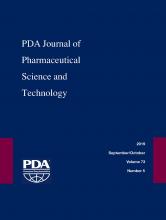Abstract
An aerosol microbial ingress test was specifically designed and used to create a predictive model in order to determine the maximum allowable leakage limit (MALL) of single-use systems (SUSs). The MALL is defined as the greatest leak size that does not pose any risk to the product. The procedure involved taking test samples of film material from single-use bags. As test samples, an ethylene vinyl acetate multilayer film (300 μm thick) and a polyethylene multilayer film (400 μm thick) were cut into 50 mm patches. Artificial defects of 1–100 µm were laser-drilled in the middle of each film patch. The patch was assembled on a holder and properly sealed. The test units were filled aseptically with culture media and placed inside an aerosol chamber. Various pressures were applied to the test unit to simulate the constraints that single-use systems may be subject to under real-world conditions. After an aerosolization cycle with spores of Bacillus atrophaeus, a minimum concentration of 106 CFU/cm2 was reached on the film surface. The test units were incubated for 14 days at 30°C–35°C and visually inspected for bacterial ingress. Thirty samples per defect size were tested. Logistic regression was used to indicate the MALL for a single-use system according to the required risk level. With this method, the probability of the occurrence or absence of ingress for a specific defect size was reported according to the experimental data. In addition to physical parameters, such as the pressure applied and the film material, the effect of the probabilistic nature of the microorganisms in determining the MALL is considered. Although finding an experimental model to predict the MALL for real-life process conditions was the ultimate objective, this paper also presents the microbial ingress test data obtained so far for two extreme conditions. Potential constraints, such as vibration, shock, acceleration, liquid movement, and pressure differentials, observed during normal usage were simulated using two extreme differential pressures, 0 mbar and 300 mbar. The estimated MALL for typical use-case conditions are 10–20 µm for storage applications and 2–10 µm for shipping conditions. The microbial integrity test method used in this article was able to detect bacterial ingress down to 3 µm defect size.
LAY ABSTRACT: As use of single-use systems (SUSs) is increasingly expanding into all process steps of commercial manufacturing, integrity failure can significantly impact drug safety, availability, and costs. Consequently, growing industry scrutiny on single-use system integrity (SUSI) is raising the need to develop good science behind reliable determinations of liquid leakage and microbial ingress as well as the appropriate physical integrity testing technologies. In the current study, microbial ingress testing by the aerosol method is used to determine the maximum allowable leakage limit (MALL) for SUSs. To define the MALL, it is generally assumed that a system or product will not show any microbial ingress or leakage at a certain defect size. Statistical analysis of the experimental data in this study indicated the MALL with probability at a certain defect size for each system. As a result, the method studied provides a more accurate way of predicting ingress and increasing safety down the line for drug manufacturers and patients alike.
- Single-use system integrity (SUSI)
- Maximum allowable leakage limit (MALL)
- Single-use system (SUS)
- Microbial ingress testing
- © PDA, Inc. 2019
PDA members receive access to all articles published in the current year and previous volume year. Institutional subscribers received access to all content. Log in below to receive access to this article if you are either of these.
If you are neither or you are a PDA member trying to access an article outside of your membership license, then you must purchase access to this article (below). If you do not have a username or password for JPST, you will be required to create an account prior to purchasing.
Full issue PDFs are for PDA members only.
Note to pda.org users
The PDA and PDA bookstore websites (www.pda.org and www.pda.org/bookstore) are separate websites from the PDA JPST website. When you first join PDA, your initial UserID and Password are sent to HighWirePress to create your PDA JPST account. Subsequent UserrID and Password changes required at the PDA websites will not pass on to PDA JPST and vice versa. If you forget your PDA JPST UserID and/or Password, you can request help to retrieve UserID and reset Password below.






